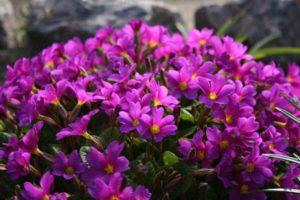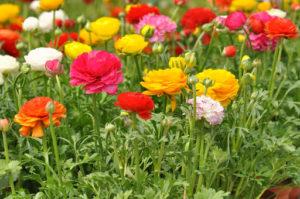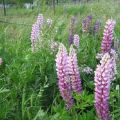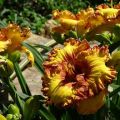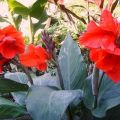Planting and caring for lupines in the open field, whether it is necessary to cut them for the winter
A great way to decorate your land is to plant bright, attractively shaped flowers. Representatives of the Legume family amaze with their aesthetic beauty, thanks to which they have become popular when creating a design for a backyard area. Lupins need proper planting and care when growing outdoors, which are recommended to be studied in advance by every gardener who wants to grow this beautiful plant.
Content
- 1 Description of culture
- 2 Varieties and varieties
- 3 Features of the use of lupine in landscape design
- 4 How to plant a flower on the site
- 5 Proper care of a perennial plant
- 6 Post-flowering care
- 7 Culture propagation methods
- 8 When to collect and how to store lupine seeds?
- 9 Tips and tricks from experienced gardeners about growing a crop
Description of culture
Lupine belongs to unpretentious perennials, characterized by a straight stem, on which palm-shaped leaves with long petioles and large-sized inflorescences in the form of a candle are alternately located. The flowers are racemose. Lupine grows 1.5 m in length, the root system is able to penetrate into the ground 1.5-2 m deep. The fruit is a pod with no more than 45 irregularly shaped seeds.
The popular name for the fruits of the plant is wolf beans, and from the Latin language the word Lupus is translated as a wolf. Lupins are from the legume family, which is characterized by the presence of a nitrogen-fixing root system. It arises from the symbiosis of bacteria that have the ability to assimilate molecular nitrogen in the air and convert it into forms accessible to plants, with root tubers.
Thanks to such interrelationships of organisms, the fruits of the plant contain proteins, which is uncharacteristic for other families, and lupine is also able to enrich the soil with nitrogen and other inorganic useful substances. This representative is considered an excellent green manure.
Common lupine is found in the area from the Pacific to the Atlantic Ocean, there are more than 200 varieties of them. In the Mediterranean-African part, 11 species of annuals grow, and only 1 of perennials. They can grow in conditions of a practical absence of moisture, therefore they are sometimes found in the deserts of California, Peru, Texas and the Sahara.
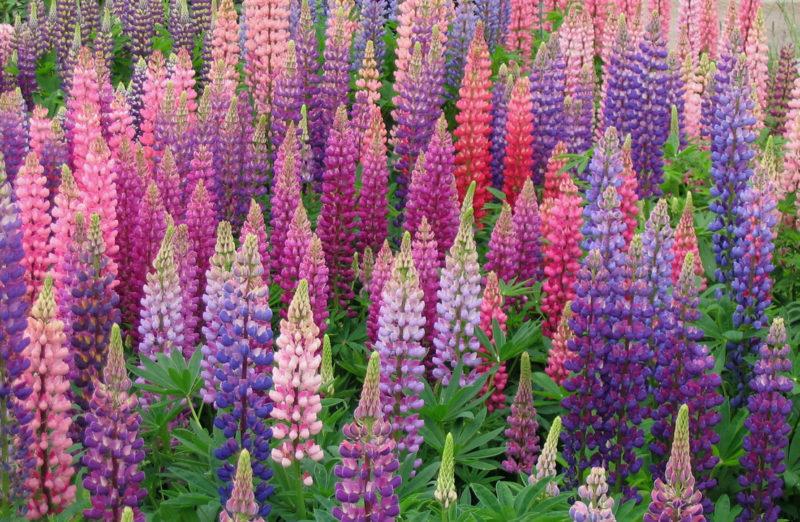
In 1911, the famous English breeder D.Russell has developed new varieties of lupine that differ from the rest by their excellent decorative properties. In honor of the manufacturer, the species were named "Russell hybrids", they are quite popular among gardeners who use them to decorate flower beds and garden plots.
Varieties and varieties
Depending on the comfort of the environment, lupine can live as an annual, biennial, perennial. Florists prefer perennial species that are successfully cultivated throughout the territory of central Russia. The most popular types are:
Narrow-leaved, or blue
Low growth plant is not more than 50 cm in height. Despite the fact that this variety of lupine is called "blue", the inflorescences can have, in addition to the characteristic shade, purple, pink, white. One representative can have a huge number of large and lush peduncles, like arctic lupine.
The plant is used as a green manure, it is characterized by unpretentiousness, winter hardiness, grows quickly and does not require additional fertilization. Some varieties, such as white-grain lupine, do not need pruning and shaping. It is important to get rid of the leafless stems and faded inflorescences in time.

When choosing lupine seeds, you should pay attention to their shape - it should be oblong oval and have a marble pattern.
Multileaf
A tall ornamental plant, reaching about 1.5 m in height, the root system deepens the same distance, and is winter hardy. It is characterized by the size of candle-shaped inflorescences 35 cm high. The most popular variety is red lupine. It blooms from June to August and likes to grow in open sunny areas.
Decorative
Ornamental varieties of lupine are mostly used to decorate summer cottages and are not used as green manure and pet food. Reaches more than 1 m in height, has a core root system. This type of lupine has various shades of inflorescences, due to which it is actively cultivated in Russia.
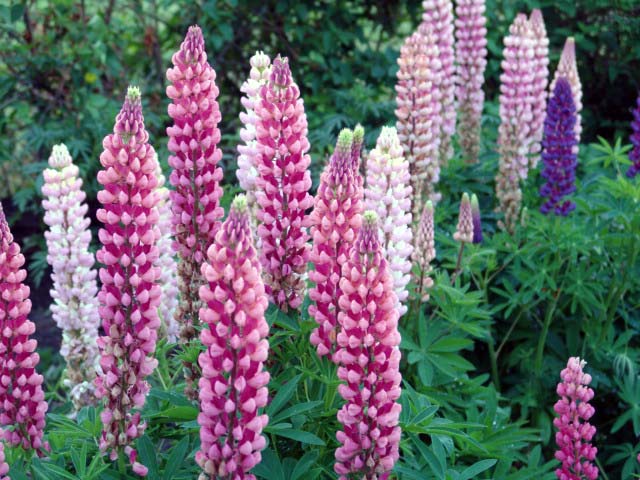
Yellow
A low plant, up to 1 m high. The inflorescences of lupine are a bit like an ear and have a yellow or light orange color. If we compare the culture with other popular varieties, then yellow lupine is more thermophilic. Since for the emergence of seedlings, at least 12 degrees of heat is required, and when frost reappears, the planting material dies. It is recommended to choose sandstone or sandy loam as a site for growth.
White
Often they decorate the local area, and also white lupine is used as a forage crop. An annual plant that grows more than 1 m tall, has a pubescent, straight stem with many branches. Lupine buds are white, collected in thin inflorescences that stretch up to 30 cm. They grow rapidly and bloom already 1.5 months after sowing. White lupine blooms for 90-150 days.

Undersized varieties
Low-growing varieties include dwarf lupine, the most common among gardeners. Its height varies from 20 to 50 cm. The leaves are gray-green. Lupine blooms throughout the summer. It is recommended to start sowing from April. The plant does not require certain strict growing and cultivation conditions and has a high germination rate.
Features of the use of lupine in landscape design
Lupine is used in the manufacture of decorative products, in the manufacture of cosmetics, hygiene products, especially soap and plaster.
The culture is great for decorating a garden plot, it looks best in single plantings, but it is also planted in a composition.
Tall varieties of lupine are used by designers to create an attractive backdrop in flower beds, and low varieties are used to form garden paths and borders.It is planted along buildings and fences, looks harmoniously with other perennials.
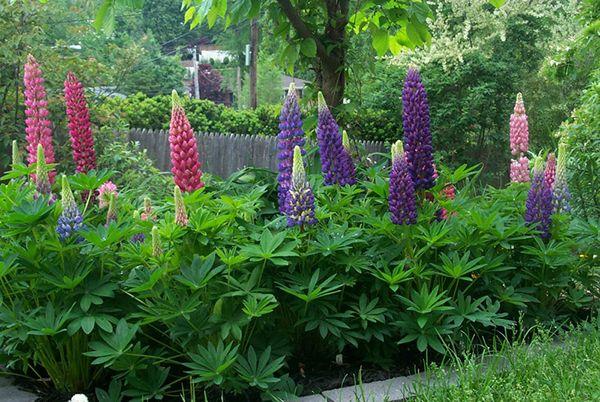
How to plant a flower on the site
Growing lupins in the garden is possible with seeds. For fast and high-quality germination of perennials, it is required to properly plant, having previously studied all the subtleties of its implementation.
How and when to plant lupins with seeds
Although lupine is an unpretentious culture, it is required to approach the planting process wisely. The site of growth should be chosen depending on the variety, since each of them prefers different lighting.
The main recommendations include partial shade or a place lit by the sun. The soil must be prepared in the autumn, it must be fresh, loose, loamy, slightly acidic.
Sowing is carried out in the spring. Equip the soil with fertilizers such as peat, sand. It is not recommended to deeply deepen the seed material. After sowing, slightly moisten the soil and cover it with foil or a damp cloth. In the future, in order for the plants to germinate quickly, observe the optimum temperature of 20-22 degrees. Thus, it is possible in a short time, namely after 2 weeks, to obtain seedlings from high quality seeds.

After 3-5 true leaves appear on the sprouts of lupine, start planting lupine seedlings in the ground in a permanent place. It is not worth time with this, since late transplantation can negatively affect the development of the root system.
You can also sow directly into open soil. To do this, in the last days of October or in the first decade of November, sowing to a depth of 2-3 cm.
Seedlings will decorate the personal plot in early May, and they will delight in flowering in August. It is important that the distance between seedlings varies from 30 to 50 cm.
The technology of planting lupine seedlings in open ground
After choosing a well-lit area, a neutral soil should be selected. In autumn, if there is acidic soil on the bed, dolomite flour should be added in an amount of 5 kg per 1 m2, and alkaline - peat in the same volume. When the seedlings get stronger, transplant them into open soil to a previously prepared place. Landing Algorithm:
- Dig holes, keeping a distance of 30-50 cm between them.
- Apply a little humus to each hole.
- Water the seedlings, let them stand for 1 hour.
- Remove seedlings with an earthen ball from the container.
- Send to the hole, trying not to violate the integrity of the roots.
- Cover with soil substrate, press down slightly with your palms.
- Water abundantly.
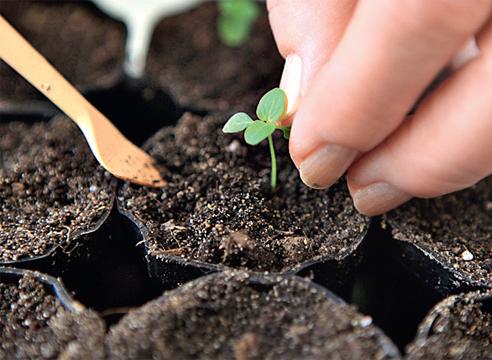
The plant will fully take root only in the next season. In the first year of life, lupine bushes will be small, and inflorescences are few.
Proper care of a perennial plant
Since the culture is unpretentious, its cultivation in the open field does not bring many problems to the gardener. The main requirements for caring for a perennial are timely weeding and high-quality feeding.
Soil and lighting requirements
Lupine grows rapidly in a predominantly sunny area, and also tolerates partial shade well. It is not recommended to plant in an area where there is no direct sunlight throughout the day.
Watering and loosening
Watering and loosening are considered mandatory procedures for breeding lupine. The abundance of moisture depends on the variety and variety of the crop, so you need to familiarize yourself with its features in advance. The main requirements include high-quality watering at the time of bud formation, since it is during this period that the perennial plant experiences the maximum lack of moisture. The rest of the time, water as needed in moderation.
After each irrigation, gently loosen the soil, taking care not to damage the root collar.
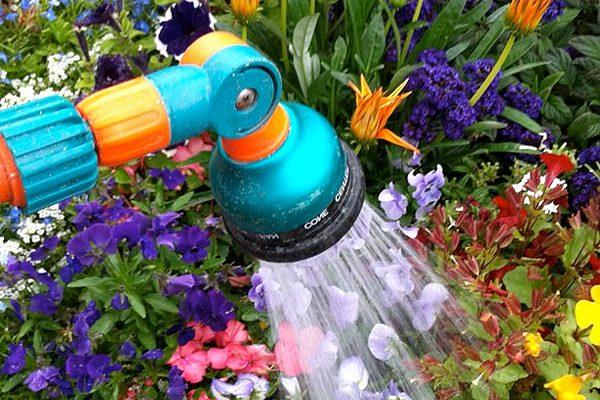
Weeding the soil on the site
Like all perennial ornamental plants, lupine needs timely weed removal, especially in the early years of growth. Further, the culture will begin to independently release alkaloid substances by the root system, which negatively affect the growth and development of many plants, including weeds. Therefore, in future years, lupine will not require regular weeding of the soil.
Top dressing
The availability of essential nutrients is an important part of caring for this perennial. For the second spring after planting lupine on the site, fertilizing using minerals is also recommended, it is also recommended to apply inorganic fertilizers.
Do not get carried away with products that contain nitrogen; when using them, you should observe a strict dosage.
For such purposes, superphosphate or calcium chloride is perfect. It must be applied in proportions of 20 and 5 g per 1 m2. Also, in a timely manner, organic matter, such as ash, should get 2 tbsp for each bush. l. fertilizers.
Fertilize the soil under the old plants annually in the spring, until the crop enters the flowering phase.

Formative pruning
Many novice gardeners are often interested in whether it is necessary to cut lupins for the winter.
In fact, an adult plant needs systematic pruning of wilted shoots and faded inflorescences, which is usually done in the fall after the abundant flowering of lupine.
Post-flowering care
It is recommended to take care of the perennial plant after flowering. This happens around October. Lupine care includes pruning flower stalks, collecting seeds that have fallen out during the tearing of beans.
Transfer: terms and rules of work
An unpleasant and time-consuming procedure for both the gardener and the plant, but still it is sometimes simply necessary. It is recommended to replant the culture in the spring. Around the bush, you need to make a trench, dig a deep groove, since the stem root sometimes goes into the ground at a distance twice as much as it grows in height on the soil surface.

Pull the bush out of the soil, get rid of the earth, trying not to damage the rather fragile roots and not to tear off the tubers with nitrogen-fixing bacteria, since without them the perennial will not survive in the future. Next, place the plant in a previously prepared hole, dug to the same depth in which the bush had previously grown.
For fast rooting, it is recommended to add a little soil from the same place. Water the transplanted bush abundantly, cover with dry soil and keep in the shade for 2 weeks.
Creating a support for tall flowers
When growing tall varieties, it is worth considering that a perennial plant is characterized by a thin and fragile stem. Under the influence of strong winds or heavy rainfall, it can break down, so you need to take care of the support of the perennial in advance. For such purposes, it is recommended to use a garden pole; in its absence, an ordinary thin stake made of wood is perfect. You do not need to tie the culture tightly, leaving a little free space.

Pests and diseases: control and prevention
Although lupine is a perennial plant with good resistance to diseases and pests, sometimes certain difficulties arise when growing it. The greatest danger to lupine is represented by:
- aphid;
- growth fly larvae;
- weevils;
- white rot;
- powdery mildew.
The causes of bacterial diseases are considered suboptimal, namely the swampy environment of lupine growth. Excessive moisture has negative consequences. Fungal diseases can occur when spores are present in the soil or seeds.
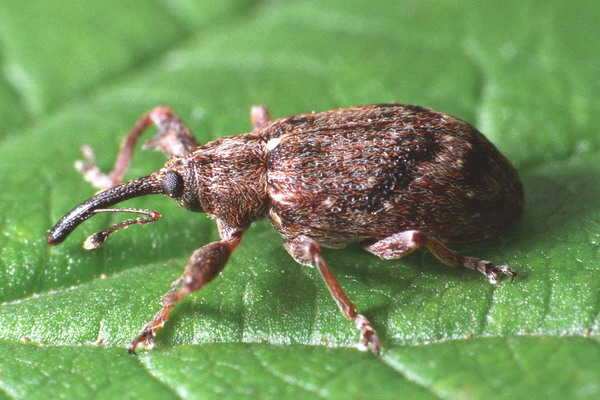
If a fungus begins to form on a perennial plant, it is necessary to get rid of the affected parts.For preventive purposes, it is recommended to treat the shrub with a solution of potassium permanganate in a ratio of 1 to 10 and periodically water the plantings with it. From pests, certain pesticides should be used by spraying flowers with them.
Preparing the plant for wintering
In order to preserve a perennial in winter, it is necessary to spud the bushes in the fall so that the root collar, the most vulnerable place, does not freeze in cold weather. It is better to mulch a perennial plant using sawdust.
It is worth remembering that the maximum lupine is able to withstand a temperature drop down to -8 degrees.
More abrupt drops in temperature can negatively affect the life of lupine.
Culture propagation methods
Lupine is cultivated using seeds or cuttings. Experts distinguish between only two types of reproduction for lupins: seed and vegetative.

Cuttings
Vegetative propagation using cuttings is recommended only for representatives aged at least 3 years. Bushes 5-6 years old also cannot be called an excellent material for seed reproduction, due to the fact that they do not have lateral buds. They need to be cut using a sharp knife at the base of the stem, preferably with part of the root collar, and planted in the shade on sandy soil.
When the root is formed at the cut cutting, it can be sent to a permanent place.
The procedure is carried out after the summer flowering, and with three-year-old bushes - in the spring, while it is worth taking cuttings with lateral shoots, with the presence of leaf axils.
Other breeding methods
Other methods of vegetative propagation include the division of the rhizome. In an old bush at least 4 years old, dig up roots in the fall, examine them for the presence of young segments, on which sprouted or dormant buds will be abundantly placed. Carefully separate such parts and plant them in a new place.
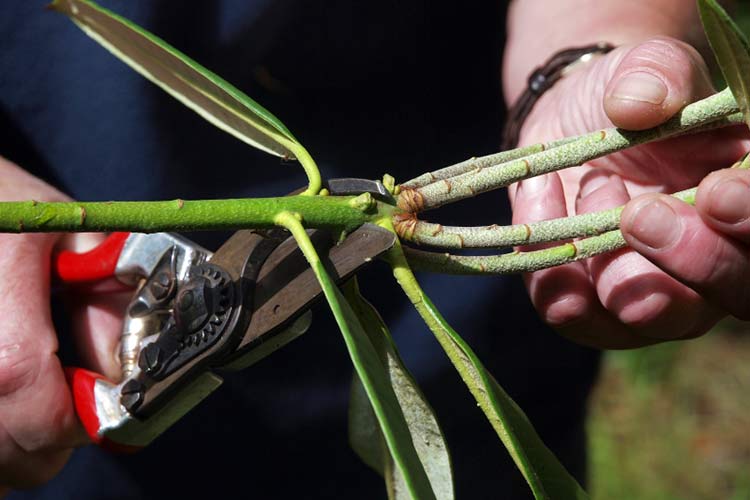
Seed propagation is considered one of the most unreliable for this species. This is due to the fact that ornamental seed varieties in the neighborhood undergo splitting by color. Therefore, to obtain a larger number, it is recommended to resort to vegetative reproduction.
When to collect and how to store lupine seeds?
During the ripening period, the fruits crack, the seeds are spread by the wind. Collecting them after the break is inconvenient, so you should take care of this in advance. Only the beans will begin to dry out a little, tie them with gauze. Then they will not crumble and after the fruits are fully ripe, they can be collected without problems.
When the fruits turn yellow, they should be carefully folded into a plastic bag and stored in a dark, dry place.
Lupine seeds have a different shape, color and the same smooth top cover, retain the possibility of germination for 5 years.
Tips and tricks from experienced gardeners about growing a crop
Before starting growing, you should carefully read the recommendations of experienced gardeners who have been growing such a perennial plant as lupine on their site for several years:
- To accelerate the germination of lupine seeds when planting on seedlings, mix the seeds with the crushed roots of an adult perennial plant.
- In the first year of planting seedlings, it is recommended to immediately cut off the inflorescences, before they have time to give seeds. This is necessary so that the lupine takes root faster and does not waste its energy on fruit production.
- In order for the perennial to flourish until the very cold, it is advised to plant it in partial shade, then it can hold out for a long time. But there is also a minus of this method - the inflorescences will not be in such a large number.
- In ancient times, lupine fruits were eaten by people, and now they can be used as animal feed due to the content of a large amount of proteins in the ground part of the perennial.
Such a bright and unusual perennial plant can also be found as a weed, but due to its presentability it is also used as a beautiful decoration for a flower bed or garden. At the same time, it does not require large expenditures of personal time and energy from the gardener, since it is considered one of the most unpretentious. If you carefully study all the rules of planting and care, then lupine for 5 years will delight others with its lush numerous buds.
